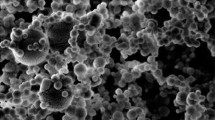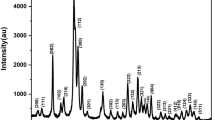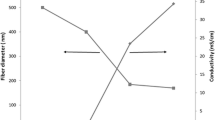Abstract
The flexible lattice of hydroxyapatite (HAP) allows for doping with ions widely varying in size and charge and these ions can impart a range of properties that could be harnessed for high technology applications. However, incorporation of combinations of ions, each of which endows HAP with different properties, has rarely been explored, let alone in combination with polymers. Carbonated hydroxyapatite (CHAP) dually doped with magnesium and selenite ions (Mg–Se–CHAP) was synthesized at different contents of the Mg2+ dopant and integrated within electrospun ε-polycaprolactone (PCL) microfibers. The formula \( {\text{Mg}}_{x} {\text{Ca}}_{{\left( {10 - x} \right)}} \left( {{\text{PO}}_{4} } \right)_{5.8} \left( {{\text{SeO}}_{2} } \right)_{0.2} \left( {\text{OH}} \right)_{2} \) represented the ceramic component of Mg–Se–CHAP/PCL fibers, whose properties were studied for different values of the stoichiometric parameter x in the 0.0 ≤ x ≤ 0.5 range. The structural investigation indicated that the lattice parameter a decreased with the addition of Mg2+ from x = 0 to x = 0.3, at which point it reached its minimal value of 9.414 Å, while the lattice parameter c increased with the addition of Mg2+ from x = 0 to x = 0.3, at which point it reached its maximal value of 7.050 Å. The morphological properties depended strongly on the Mg2+ content, as the fibrous scaffolds became more networked, rougher on the surface, and less porous with the addition of Mg2+. All of these surface properties affected the human fibroblastic HFB4 cell response to these materials. While the cell viability tests indicated a perfectly safe response toward the cells after 3 days of exposure, the cell adhesion, and proliferation improved upon the addition of Mg2+ to the Se–CHAP phase, and infiltration into surface pores varied, again as a function of the Mg2+ content. The mechanical properties were also strongly affected by the Mg2+ concentration, with tensile strength, fracture toughness and elastic modulus all recording their highest values for the x = 0.2 composition, typically being a dozen times higher than the values recorded for the Mg2+-free, x = 0.0 composition. These results show that a range of composite scaffold properties combining a polymer as the main phase (88 wt%) and HAP as the secondary phase (12 wt%), including the microstructural, mechanical and biological, can be tuned by controlling a relatively subtle and inconspicuous compositional parameter—the content of the Mg2+ dopant incorporated in the structure of HAP. Despite the low content of this ion in the dually doped CHAP/PCL microfibrous matrix, ranging between the Mg2+/Ca2+ molar ratios of 1:100 and 1:20, the high dependency of the material properties on the concentration of Mg2+ suggests that this approach may warrant further investigation for potential clinical applications.













Similar content being viewed by others
References
Bose S, Vu AA, Emshadi K, Bandyopadhyay A (2018) Effects of polycaprolactone on alendronate drug release from Mg-doped hydroxyapatite coating on titanium. Mater Sci Eng, C 88:166–171
Heshmatpour F, Lashteneshaee SH, Samadipour M (2018) Study of in vitro bioactivity of nano hydroxyapatite composites doped by various cations. J Inorg Organomet Polym Mater 28:2063–2068
Wei L, Yang H, Hong J, He Z, Deng C (2018) Synthesis and structure properties of Se and Sr co-doped hydroxyapatite and their biocompatibility. J Mater Sci 54:2514–2525. https://doi.org/10.1007/s10853-018-2951-7
Ahmed MK, Ramadan R, El-dek SI, Uskoković V (2019) Complex relationship between alumina and selenium-doped carbonated hydroxyapatite as the ceramic additives to electrospun polycaprolactone scaffolds for tissue engineering applications. J Alloy Compd 801:70–81
Basirun WJ, Nasiri-Tabrizi B, Baradaran S (2017) Overview of hydroxyapatite-graphene nanoplatelets composite as bone graft substitute: mechanical behavior and in-vitro biofunctionality. Crit Rev Solid State Mater Sci 43:177–212
Zioupos P, Currey JD (1998) Changes in the stiffness, strength, and toughness of human cortical bone with age. Bone 22:57–66
Wang X, Shen X, Li X, Agrawal CM (2002) Age-related changes in the collagen network and toughness of bone. Bone 31:1–7
Launey ME, Buehler MJ, Ritchie RO (2010) On the mechanistic origins of toughness in bone. Annu Rev Mater Res 40:25–53
Szurkowska K, Zgadzaj A, Kuras M, Kolmas J (2018) Novel hybrid material based on Mg2 + and SiO44- co-substituted nano-hydroxyapatite, alginate and chondroitin sulphate for potential use in biomaterials engineering. Ceram Int 44:18551–18559
Luo H, Xie J, Xiong L, Yang Z, Zuo G, Wang H et al (2018) Engineering photoluminescent and magnetic lamellar hydroxyapatite by facile one-step Se/Gd dual-doping. J Mater Chem B 6:3515–3521
Castiglioni S, Cazzaniga A, Albisetti W, Maier JA (2013) Magnesium and osteoporosis: current state of knowledge and future research directions. Nutrients 5:3022–3033
Neuman WF, Yan BJM (1971) Synthetic hydroxyapatite crystals IV magnesium incorporation. Calcif Tissue Res 7:133–138
Tomazic B, Tomson M, Nancollas G (1975) Growth of calcium phosphates on hydroxyapatite crystals: the effect of magnesium. Arch Oral Biol 20:803–808
Serre CM, Papillard M, Chavassieux P, Voegel JC, Boivin G (1998) Influence of magnesium substitution on a collagen–apatite biomaterial on the production of a calcifying matrix by human osteoblasts. J Biomed Mater Res 42:626–633
Vecchio KS, Zhang X, Massie JB, Wang M, Kim CW (2007) Conversion of sea urchin spines to Mg-substituted tricalcium phosphate for bone implants. Acta Biomater 3:785–793
Landi E, Logroscino G, Proietti L, Tampieri A, Sandri M, Sprio S (2008) Biomimetic Mg-substituted hydroxyapatite: from synthesis to in vivo behaviour. J Mater Sci Mater Med 19:239–247
Kozuma W, Kon K, Kawakami S, Bobothike A, Iijima H, Shiota M, et al (2019) Osteoconductive potential of a hydroxyapatite fiber material with magnesium: In vitro and in vivo studies. Dental Mater J
Alioui H, Bouras O, Bollinger JC (2019) Toward an efficient antibacterial agent: zn- and Mg-doped hydroxyapatite nanopowders. J Environ Sci Health, Part A 54:315–327
Andres NC, Sieben JM, Baldini M, Rodriguez CH, Famiglietti A, Messina PV (2018) Electroactive Mg(2 +)-hydroxyapatite nanostructured networks against drug-resistant bone infection strains. ACS Appl Mater Interfaces 10:19534–19544
Menale C, Campodoni E, Palagano E, Mantero S, Erreni M, Inforzato A et al (2019) Mesenchymal stromal cell-seeded biomimetic Scaffolds as a factory of soluble RANKL in rankl-deficient osteopetrosis. Stem Cells Transl Med 8:22–34
Roffi A, Kon E, Perdisa F, Fini M, Di Martino A, Parrilli A et al (2019) A composite Chitosan-reinforced scaffold fails to provide osteochondral regeneration. Int J Mol Sci 20:2227
Shoeibi S, Mozdziak P, Golkar-Narenji A (2017) Biogenesis of selenium nanoparticles using green chemistry. Top Curr Chem 375:88
Wang Y, Ma J, Zhou L, Chen J, Liu Y, Qiu Z et al (2012) Dual functional selenium-substituted hydroxyapatite. Interface Focus 2:378–386
Zhang W, Chai Y, Cao N, Wang Y (2014) Synthesis and characterization of selenium substituted hydroxyapatite via a hydrothermal procedure. Mater Lett 134:123–125
Kolmas J, Oledzka E, Sobczak M, Nalecz-Jawecki G (2014) Nanocrystalline hydroxyapatite doped with selenium oxyanions: a new material for potential biomedical applications. Mater Sci Eng C Mater Biol Appl 39:134–142
Liu H, Li X, Qin F, Huang K (2014) Selenium suppresses oxidative-stress-enhanced vascular smooth muscle cell calcification by inhibiting the activation of the PI3K/AKT and ERK signaling pathways and endoplasmic reticulum stress. J Biol Inorg Chem 19:375–388
Wang Y, He W, Hao H, Wu J, Qin N (2018) Eggshell derived Se-doped HA nanorods for enhanced antitumor effect and curcumin delivery. J Sol-Gel Sci Technol 87:600–607
Sun J, Zheng X, Li H, Fan D, Song Z, Ma H et al (2017) Monodisperse selenium-substituted hydroxyapatite: controllable synthesis and biocompatibility. Mater Sci Eng C Mater Biol Appl 73:596–602
Wei L, Pang D, He L, Deng C (2017) Crystal structure analysis of selenium-doped hydroxyapatite samples and their thermal stability. Ceram Int 43:16141–16148
Gorodzha SN, Surmeneva MA, Selezneva II, Ermakov AM, Zaitsev VV, Surmenev RA (2018) Investigation of the morphology and structure of porous hybrid 3D scaffolds based on polycaprolactone involving silicate-containing hydroxyapatite. J Surf Invest 12:717–726
Torres E, Fombuena V, Valles-Lluch A, Ellingham T (2017) Improvement of mechanical and biological properties of Polycaprolactone loaded with hydroxyapatite and halloysite nanotubes. Mater Sci Eng C Mater Biol Appl 75:418–424
Ahmed MA, Mansour SF, El-dek SI, Abd-Elwahab SM, Ahmed MK (2014) Characterization and annealing performance of calcium phosphate nanoparticles synthesized by co-precipitation method. Ceram Int 40:12807–12820
Lim SH, Liu XY, Song H, Yarema KJ, Mao HQ (2010) The effect of nanofiber-guided cell alignment on the preferential differentiation of neural stem cells. Biomaterials 31:9031–9039
Srikanth M, Asmatulu R, Cluff K, Yao L (2019) Material characterization and bioanalysis of hybrid scaffolds of carbon nanomaterial and polymer nanofibers. ACS Omega 4:5044–5051
Ahmed MK, Mansour SF, Mostafa MS, Darwesh R, El-dek SI (2018) Structural, mechanical and thermal features of Bi and Sr co-substituted hydroxyapatite. J Mater Sci 54:1977–1991. https://doi.org/10.1007/s10853-018-2999-4
Xu HH, Weir MD, Burguera EF, Fraser AM (2006) Injectable and macroporous calcium phosphate cement scaffold. Biomaterials 27:4279–4287
Mansour SF, El-dek SI, Ismail M, Ahmed MK (2018) Structure and cell viability of Pd substituted hydroxyapatite nano particles. Biomed Phys Eng Express 4:045008
Safarzadeh M, Ramesh S, Tan CY, Chandran H, Noor AFM, Krishnasamy S et al (2019) Effect of multi-ions doping on the properties of carbonated hydroxyapatite bioceramic. Ceram Int 45:3473–3477
Uskoković V (2015) The role of hydroxyl channel in defining selected physicochemical peculiarities exhibited by hydroxyapatite. RSC Adv 5:6614–36633
Geng Z, Cui Z, Li Z, Zhu S, Liang Y, Liu Y et al (2016) Strontium incorporation to optimize the antibacterial and biological characteristics of silver-substituted hydroxyapatite coating. Mater Sci Eng C Mater Biol Appl 58:467–477
Lala S, Ghosh M, Das PK, Das D, Kar T, Pradhan SK (2016) Magnesium substitution in carbonated hydroxyapatite: structural and microstructural characterization by Rietveld’s refinement. Mater Chem Phys 170:319–329
Sattary M, Khorasani MT, Rafienia M, Rozve HS (2018) Incorporation of nanohydroxyapatite and vitamin D3 into electrospun PCL/Gelatin scaffolds: the influence on the physical and chemical properties and cell behavior for bone tissue engineering. Polym Adv Technol 29:451–462
Zhu B, Wang S, Wang L, Yang Y, Liang J, Cao B (2017) Preparation of hydroxyapatite/tannic acid coating to enhance the corrosion resistance and cytocompatibility of AZ31 magnesium alloys. Coatings 7:105
Vesna M-S, Sanja E, Ana J, Maja V-S, Miodrag M, Jung YC et al (2015) Electrochemical synthesis of nanosized hydroxyapatite/graphene composite powder. Carbon Lett 16:233–240
Youness RA, Taha MA, El-Kheshen AA, Ibrahim M (2018) Influence of the addition of carbonated hydroxyapatite and selenium dioxide on mechanical properties and in vitro bioactivity of borosilicate inert glass. Ceram Int 44:20677–20685
Mansour SF, El-dek SI, Dorozhkin SV, Ahmed MK (2017) Physico-mechanical properties of Mg and Ag doped hydroxyapatite/chitosan biocomposites. New J Chem 41:13773–13783
Lincks J, Boyan BD, Blanchard CR, Lohmann CH, Liu Y, Cochran DL et al (1998) Response of MG63 osteoblast-like cells to titanium and titanium alloy is dependent on surface roughness and composition. Biomaterials 19:2219–2232
Mansour SF, El-dek SI, Ahmed MK (2017) Tailoring the structure of biphasic calcium phosphate via synthesis procedure. Mater Res Express 4:125015
Shkarina S, Shkarin R, Weinhardt V, Melnik E, Vacun G, Kluger P et al (2018) 3D biodegradable scaffolds of polycaprolactone with silicate-containing hydroxyapatite microparticles for bone tissue engineering: high-resolution tomography and in vitro study. Sci Rep 8:8907
Eftekhari H, Jahandideh A, Asghari A, Akbarzadeh A, Hesaraki S (2017) Assessment of polycaprolacton (PCL) nanocomposite scaffold compared with hydroxyapatite (HA) on healing of segmental femur bone defect in rabbits. Artif Cells Nanomed Biotechnol 45:961–968
Youness RA, Taha MA, Elhaes H, Ibrahim M (2017) Molecular modeling, FTIR spectral characterization and mechanical properties of carbonated-hydroxyapatite prepared by mechanochemical synthesis. Mater Chem Phys 190:209–218
Tang S, Tian B, Guo Y-J, Zhu Z-A, Guo Y-P (2014) Chitosan/carbonated hydroxyapatite composite coatings: fabrication, structure and biocompatibility. Surf Coat Technol 251:210–216
Wang Y, Hao H, Zhang S (2017) Biomimetic coprecipitation of silk fibrin and calcium phosphate: influence of selenite ions. Biol Trace Elem Res 178:338–347
Duta L, Mihailescu N, Popescu AC, Luculescu CR, Mihailescu IN, Çetin G et al (2017) Comparative physical, chemical and biological assessment of simple and titanium-doped ovine dentine-derived hydroxyapatite coatings fabricated by pulsed laser deposition. Appl Surf Sci 413:129–139
Murugan N, Murugan C, Sundramoorthy AK (2018) In vitro and in vivo characterization of mineralized hydroxyapatite/polycaprolactone-graphene oxide based bioactive multifunctional coating on Ti alloy for bone implant applications. Arab J Chem 11:959–969
Fadeeva IV, Barinov SM, Fedotov AY, Komlev VS (2012) Interactions of calcium phosphates with chitosan. Doklady Chem 441:387–390
Zhang W, Xu X, Chai Y, Wang Y (2016) Synthesis and characterization of Zn2 + and SeO32 − co-substituted nano-hydroxyapatite. Adv Powder Technol 27:1857–1861
Sattary M, Rafienia M, Khorasani MT, Salehi H (2018) The effect of collector type on the physical, chemical, and biological properties of polycaprolactone/gelatin/nano-hydroxyapatite electrospun scaffold. J Biomed Mater Res Part B Appl Biomat 107:933–950
Author information
Authors and Affiliations
Corresponding author
Additional information
Publisher's Note
Springer Nature remains neutral with regard to jurisdictional claims in published maps and institutional affiliations.
Rights and permissions
About this article
Cite this article
Ahmed, M.K., Mansour, S.F., Al-Wafi, R. et al. Tuning the mechanical, microstructural, and cell adhesion properties of electrospun ε-polycaprolactone microfibers by doping selenium-containing carbonated hydroxyapatite as a reinforcing agent with magnesium ions. J Mater Sci 54, 14524–14544 (2019). https://doi.org/10.1007/s10853-019-03947-1
Received:
Accepted:
Published:
Issue Date:
DOI: https://doi.org/10.1007/s10853-019-03947-1




